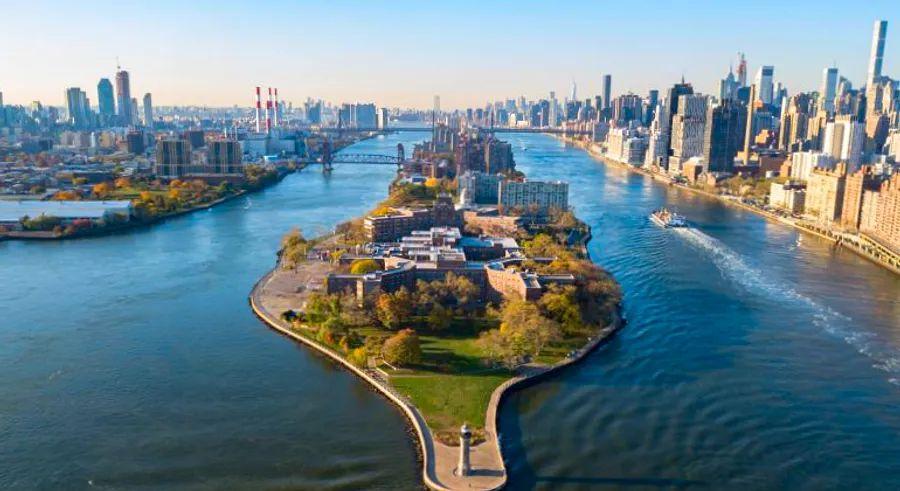A hotel is making its debut on NYC’s Roosevelt Island, known for its dark history

New York’s Roosevelt Island, a narrow two-mile stretch in the East River with a fascinating past and a promising tech-driven future, is soon to welcome its first hotel guests.
The 224-room Graduate Roosevelt Island opens its doors on June 1. Located at the entrance of the cutting-edge Cornell Tech campus, the 18-story building will be the Graduate brand’s 29th property and its first in New York City.
‘Being able to have a hotel in New York City that’s still connected to a campus and a major university like Cornell… and essentially being a gateway to New York’s tech industry, was a rare and exciting opportunity for us,’ said David Rochefort, president of Graduate Hotels and a Cornell alum.
The expanding Cornell Tech campus—its first phase launched in 2017—is marking a new era for Roosevelt Island, once known for its 19th-century penitentiary, workhouses, smallpox hospital, and mental asylum.
In 1887, pioneering investigative journalist Nellie Bly faked mental illness to get admitted to the asylum, leading to her famous exposé ‘Ten Days in a Mad-House,’ which uncovered the facility's mistreatment and poor conditions.
Though traces of this dark past still linger, the island is now home to sleek, modern buildings at Cornell Tech. The Graduate hotel seeks to merge the old and the new, honoring the island’s history, Cornell’s legacy, and a cutting-edge future.

Inside the hotel
The lobby blends tactile elements of classic education with a modern twist, featuring a laptop-friendly library table, domed task lamps, and textbooks stacked high to the ceiling.
‘We love the idea of grounding our lobby in the past,’ said Rochefort. ‘So, one of the things we did was install 5,000 linear feet of textbooks along the entire lobby wall.’
Students and entrepreneurs, just across the courtyard from the hotel, will gain a fresh perspective on the future and what they’re building for tomorrow, Rochefort added.
The space also has a playful touch. A giant boy in aviator goggles holds a light bulb above the front desk—a 12-foot sculpture by Hebru Brantley that reimagines his signature Flyboy character.
As with all Graduate Hotels, the key cards resemble college IDs—this time showcasing Cornell alumni with notable ties to New York City, like Ruth Bader Ginsburg from the Ithaca campus.

The interiors are designed by Graduate Hotels' in-house team, while the building’s striking architecture—designed to capture views of Manhattan, Queens, and beyond—comes from Snøhetta and Stonehill Taylor.
In the rooms, classic collegiate plaid accents complement light fixtures inspired by a Cornell alum's science project, and lamp bases feature a Morse code version of Cornell’s fight song.
New York-based artists have incorporated playful references to Nellie Bly and actress Mae West, who was briefly incarcerated on the island in 1927 for public obscenity charges.
At the top of the hotel, a futuristic rooftop bar and event space will offer panoramic views and a menu crafted by Med Abrous and Marc Rose, the NYC natives and Los Angeles-based restaurateurs behind the dining offerings at several Graduate locations.

On the island
Originally known as Minnahanonck, Roosevelt Island was bought from Native Americans by the Dutch in 1637 and became part of New York City in 1828. By then, it was called Blackwell’s Island.
Blackwell House, a restored 1796 farmhouse, was once owned by the family that held title to the island before it was sold to the city. The house is now open to the public.
The island was later renamed Welfare Island before becoming Roosevelt Island in 1973, in honor of President Franklin D. Roosevelt.

At the southern tip of the island, Four Freedoms Park serves as a memorial to the island’s namesake, Franklin D. Roosevelt.
Although many of its original buildings are no longer standing, Roosevelt Island still boasts some significant historical landmarks. The ivy-covered ruins of the smallpox hospital, designed by James Renwick Jr. of the Smithsonian Institution, stand as a stark reminder of the island’s past. At the northern tip, a Renwick-designed lighthouse anchors a nearby park.
A distinctive octagonal tower, once part of the asylum for the mentally ill, has been incorporated into a modern apartment development, reflecting the island’s ongoing transformation.
Roosevelt Island is accessible by car, the F Train, and the scenic aerial Tramway, which has provided stunning views since it opened in 1976.

1

2

3

4

5
Evaluation :
5/5